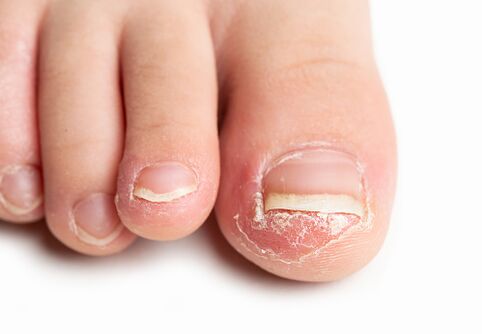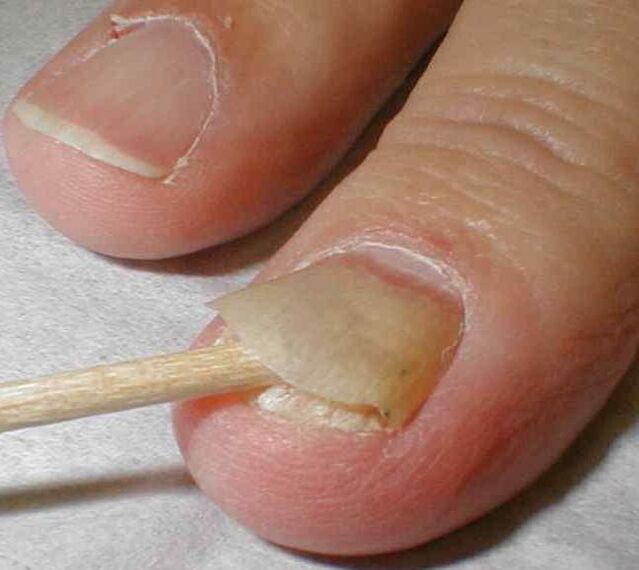This article will focus on such an unpleasant but, alas, quite common phenomenon, such as nail fungus. The symptoms and causes of this disease are known to medical science and can be easily diagnosed at all stages. However, it can only be detected with care for one's own health. How to identify toenail fungus? How to treat? Are the advertised ointments effective?

What causes nail fungus?
Nail fungus is a fairly common disease. The disease spreads particularly successfully in temperate and tropical climates, ie where it is humid and warm. It is paradoxical, however, that the inhabitants of cold countries most often get nail fungus. This is due to the fact that in harsh climates you constantly have to wear warm shoes with socks. The foot sweats, the sock gets wet and the person is forced to stay in this state for a long time without the opportunity to change shoes. This is the best way to promote the formation of nail fungus. Before we talk about how to identify toenail fungus, let's find out who is more susceptible to this disease.
Nail fungus as an occupational disease
At risk are people whose feet cannot breathe during the day due to tight shoes. These are miners, power plant workers, gardeners and representatives of other working specialties. The fungus can "boast" by working in the laundry, in the pool, hotel, restaurant.
What diseases can serve as a prerequisite
Often not only members of the above professions suffer from this disease, but also people who have type 1 or 2 diabetes. In addition, deformity of the legs, varicose veins can be a prerequisite for the formation of fungus on the nails. Among the causes of this infection is insufficient nutrition of the nails due to blockage or blockage of blood vessels. That is why the creams advertised today, as well as nail polishes designed to protect against fungus, will be completely useless in the fight against disease. After all, it is often caused by internal diseases and external influences will not eradicate the problems.
Who is at risk?
Decades ago, nail fungus was diagnosed in most cases in the elderly. However, every year the number of patients suffering from nail fungus increases and the disease itself becomes younger.
Official data show that nail fungus develops two to three times more often in men. At the same time, women are the ones who turn to a dermatologist with this problem much more often. The fairer sex is more concerned about their health and does not find anything embarrassing when consulting a doctor.
Then we will look at why it is so important to get recommendations for the treatment of fungus from a dermatologist, and we will also talk about how you can identify nail fungus and what symptoms it has at each stage of its development.

What does nail fungus look like?
This disease is not fatal, but, of course, it is necessary to get rid of it. Fortunately, recognizing the onset of the disease is easy for everyone. How to identify foot fungus? See below for tips. First of all, take a closer look at your nails.
The first thing to watch out for is this nail color. The nail affected by the fungus becomes dull yellow and opaque. Depending on the stage of the disease, the affected area may be the edge of the nail plate, the base or the entire nail.
Pay attention to the thickness of the nail
When answering the question of how to identify nail fungus, changes in the nail plate should also be mentioned. Despite the fact that due to the disease, the nail becomes thinner, visually and sensationally it looks thicker and swollen.
How to recognize nail fungus? Visual examination of the nail plate is not sufficient to detect the presence of infection. Mix potassium permanganate and water in a ratio of 1 to 5, immerse the nails in the resulting solution for half a minute. A healthy nail will be colored and brown. Part of the affected plate will remain white.
Stages of the disease
The disease occurs in four stages. The earlier you start treatment, the more likely you are to get rid of nail fungus forever.
The first stage is characterized by damage to the edge of the nail. As mentioned above, the color of the plate changes, bulges appear. The nail grows poor quality, hollow and therefore breaks and crumbles.
The increase in the area of the lesion will become a sign of the second stage. In addition, it should be noted that sometimes the second stage can begin, as if bypassing the first. The defeat of the nail plate will start not from the edge, but at the base of the nail. Recovery from nail fungus in the second stage will be more problematic than in the first.
How to identify nail fungus in stage 3? In medicine it is called a sponge with a white surface and it seems that the whole plate is affected. It has a thick white color, it crumbles strongly at the edges.
The fourth stage is called total dystrophic fungus. The nail has a yellowish-gray color, emits a particularly unpleasant odor and crumbles heavily. In the fourth stage, you can often see the exposed part of the skin under the broken nail, as it has grown due to the fungus, in most cases it breaks off.

The reason for contacting a dermatologist is often the independent identification of the fourth stage of nail fungus. Don't look on forums or the internet for advice on how to effectively treat nail fungus. It is better to consult a specialist at the first symptoms of the disease.
What to expect from a visit to the doctor?
Probably every one of us has a fear of doctors. However, do not be afraid to contact a dermatologist if you suspect that you have nail fungus. The specialist will perform an external examination and will also scrape the upper stratum corneum of the nail to send it to the diagnostic laboratory. A detailed analysis will reveal the cause of the disease, determine the type of fungus and also tell the doctor what type of treatment should be prescribed.
The treatment of nail fungus takes a long time. It can last from one month to three. After the course of treatment you will have to take tests again, even if the above symptoms are not observed.
A few words about effective treatment
So now we know how to identify toenail fungus. The methods are given above. Now it is worth saying a few words about the treatment you can do yourself. Naftifine has been shown to be quite effective. However, it is not necessary to use an ointment, but a solution. This medicine can also be used in case of a fungal infection of the feet.
How should I use Naftifin? If you have fungus in the first stage of the disease, then lubricate the affected nail surface twice a day. Keep your nails dry and well washed. In the next stages of the disease, you cannot do without taking pills. In this case, however, the use of Naftifin should not be stopped: this will increase the effect of the drugs.
Before applying the product, clean the well-affected surface of the nail with a manicure device. However, you need to be extremely careful when doing this. After perfect manipulations it is necessary to apply Naftifin solution on the cleaned area. Repeat 2 times a day.
Summary
The article answers the question of how to identify toenail fungus. However, it is worth remembering that self-medication does not always lead to full recovery. If the thickness or color of your nails changes, you should consult a doctor.
According to the degree of damage to the nail plate, the fungus can be divided into four stages. If in the first stage the disease does not cause anxiety because it does not significantly deform the nail plate, then in the fourth stage you can easily lose your nails. Do not hesitate to contact a dermatologist.
It is strongly recommended not to self-medicate, giving in to advertising admonitions about the effectiveness of a drug. The cream or other agent applied to the nail plate from the outside will not get rid of the cause of the disease and will therefore be ineffective. As a result, you will only slow down the healing process, masking the manifestation of the disease. It is also worth remembering that nail fungus not only looks unsightly, but is also a kind of beacon showing the presence of disorders in the body.
















